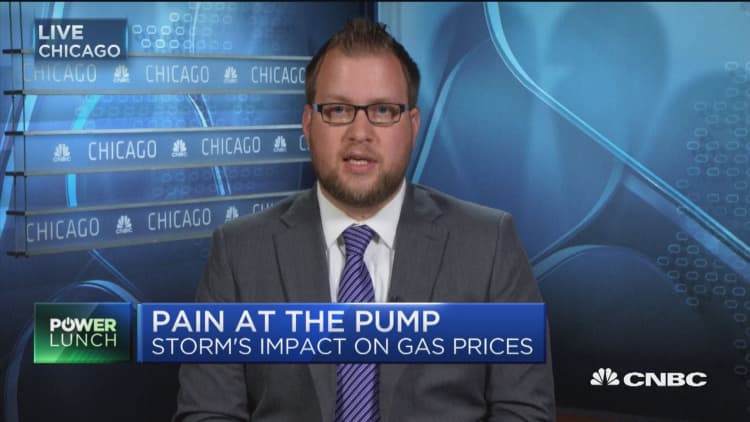
Harvey's hit on the Gulf Coast refining industry has driven gasoline prices at the pump to a two-year high, and retailers are expected to continue passing on price increases over the Labor Day weekend.
According to AAA, the national average rose to $2.52 per gallon for unleaded gasoline Friday, up from $2.45 Thursday and $2.33 before the hurricane hit the Gulf Coast. In some areas, prices jumped by double digits overnight, and there could be more sharp, but temporary gains ahead as distributors struggle with reduced supplies.
"Demand does go down after Labor Day. There's a bunch of good news out there, but the reality is we don't know what's going on with refineries," said Jeff Lenard, vice president, strategic industry initiatives, National Association of Convenience Stores. Convenience stores sell about 80 percent of the gasoline in the U.S.
Prices should continue to rise into next week, but are expected to level off and back down as refineries come back online and gasoline moves through the system, analysts said. The national average could rise as much as 20 to 30 cents more before it begins to steady.
Tom Kloza, global head of energy analysis at Oil Price Information Service, expects gasoline to rise to $2.75 per gallon. He said the condition of several major refineries is still unclear, and the U.S. gasoline supply is complicated by the fact that the U.S. is now a significant exporter of gasoline to central and South America.
Kloza said because of those factors, prices could stay high during September, but start to drop late in October.
Harvey forced refineries to reduce processing by about 5 million barrels a day as facilities from Corpus Christi, Texas, to Lake Charles, Louisiana, cut back or shut down. But a portion of that is now being restored.
"We're in the process of restoring runs of crude processing by 1.8 million barrels a day, and several refineries will be increasing their rate of processing at their rated capacity in the next few days," said Andrew Lipow, president of Lipow Oil Associates.
He said Marathon and Valero refineries in Texas City are on stream and ramping up operations, as is the Houston Valero refinery.
"I think 14 percent of U.S. refining capacity is completely shut down. About another 14 percent or so is in the midst of ramping up operations," Lipow said.
In some markets where the flow of gasoline is not as abundant as it had been, prices were up much more. In Missouri, pump prices jumped 8 cents since Thursday, to $2.38 per gallon, up 25 cents in the past week. Missouri and other Midwest states are impacted by the reduced volumes in the Explorer Pipeline.
In northern Texas, prices were also much higher. Motorists were lining up for gasoline in Dallas, where prices jumped from an average $2.37 per gallon Thursday to $2.52 per gallon by Friday, according to AAA.
"Part of it is Dallas is supplied by a pipeline from Corpus Christi, and of course those pipelines have been down," said Lipow. "There was a social media explosion of panic, so everyone went to the gas station. Supplies are going to be tight but they're going to get better."
Lenard said the best thing consumers can do is not to panic and top off gas tanks.
"I talked to people in Dallas that are going as far as Denver to get product. Basically it's a demand issue, not a supply issue," he said. "The system is equipped to have everybody with a half tank or so. When there's too many people with a full tank, there 's too many people with an empty tank."
In South Carolina, the price of unleaded averaged $2.39 per gallon by Friday morning, up 13 cents from Thursday. The Southeast is served by the Colonial Pipeline which was operating but at a lower volume. In Atlanta, the average price was $2.51, up 11 cents from Thursday.
"The hot spot to watch out for would be the east coast and New York harbor," said Kloza. Analysts said some shipments coming into New York were heading to Florida, which had been served by ships from Texas. In the futures market, New York harbor gasoline, or RBOB futures for October were trading down 2.7 percent at $1.73 per gallon on the NYMEX.
There remains questions about some of the major refineries, as others return to operation.
The Motiva refinery in Port Arthur, the largest U.S. refinery , could be down for a month, Lipow said. "That's based on the fact that it's going to take two weeks to assess damage and at least two weeks to get back on stream," he said.
The ExxonMobil Baytown refinery, the second largest refinery, has had some flooding and also could be down for up to four weeks, he said.
WATCH: Labor Day travelers should expect big price hikes



